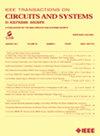Bifurcation Analysis of Slow-Scale Oscillation in SIDO Boost PFC Converter Using Time-Frequency Characteristic Representation Method
IF 4.9
2区 工程技术
Q2 ENGINEERING, ELECTRICAL & ELECTRONIC
IEEE Transactions on Circuits and Systems II: Express Briefs
Pub Date : 2025-07-29
DOI:10.1109/TCSII.2025.3593639
引用次数: 0
Abstract
Besides line frequency excitation, strong nonlinear crossing effect amongst three input/output ports exists in single-inductor dual-output (SIDO) boost power factor correction (PFC) converters, which leads to the occurrence of complex behaviors including slow-scale oscillation. In this brief, a nonlinear averaged model is derived to describe the nonlinear time-periodic coupling (NTPC) effect of the SIDO PFC converter, and importantly time-frequency characteristic representation method is proposed to obtain the analytical expression of periodic equilibrium solutions. Furthermore, two types of slow-scale oscillations are identified with the help of the loci movement of Floquet multipliers. It is shown that period-doubling bifurcation and Hopf bifurcation are responsible for type I alternating peak oscillation and type II discontinuous trajectory oscillation, respectively. Especially, Hopf bifurcation results in one incommensurable frequency component with respect to the line frequency, which explains the reason why the system enters one quasi-periodic orbit. Finally, these experimental results are given to verify the theoretical analysis. These above results are beneficial to guide circuit optimal design.基于时频特性表示法的SIDO升压PFC变换器慢尺度振荡分岔分析
在单电感双输出(SIDO)升压功率因数校正(PFC)变换器中,除了线频激励外,三个输入/输出端口之间还存在较强的非线性交叉效应,从而导致慢尺度振荡等复杂行为的发生。本文推导了一个非线性平均模型来描述SIDO PFC变换器的非线性时间周期耦合效应,并提出了重要的时频特性表示方法来获得周期平衡解的解析表达式。在此基础上,利用Floquet乘法器的轨迹运动识别出两种慢尺度振荡。结果表明,倍周期分岔和Hopf分岔分别引起了I型交变峰值振荡和II型不连续轨迹振荡。特别是Hopf分岔导致了一个相对于线频不可通约的频率分量,这解释了系统进入一个准周期轨道的原因。最后给出了实验结果来验证理论分析。这些结果有利于指导电路的优化设计。
本文章由计算机程序翻译,如有差异,请以英文原文为准。
求助全文
约1分钟内获得全文
求助全文
来源期刊
CiteScore
7.90
自引率
20.50%
发文量
883
审稿时长
3.0 months
期刊介绍:
TCAS II publishes brief papers in the field specified by the theory, analysis, design, and practical implementations of circuits, and the application of circuit techniques to systems and to signal processing. Included is the whole spectrum from basic scientific theory to industrial applications. The field of interest covered includes:
Circuits: Analog, Digital and Mixed Signal Circuits and Systems
Nonlinear Circuits and Systems, Integrated Sensors, MEMS and Systems on Chip, Nanoscale Circuits and Systems, Optoelectronic
Circuits and Systems, Power Electronics and Systems
Software for Analog-and-Logic Circuits and Systems
Control aspects of Circuits and Systems.

 求助内容:
求助内容: 应助结果提醒方式:
应助结果提醒方式:


